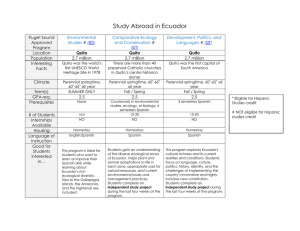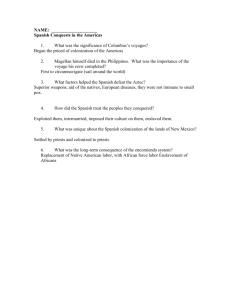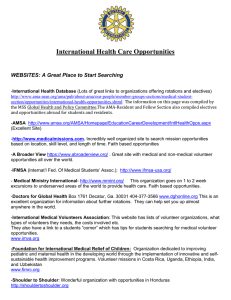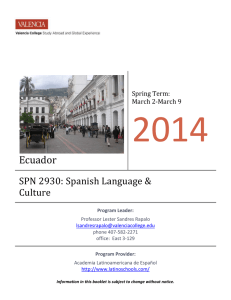Nathaniel Hsu MS IV
advertisement
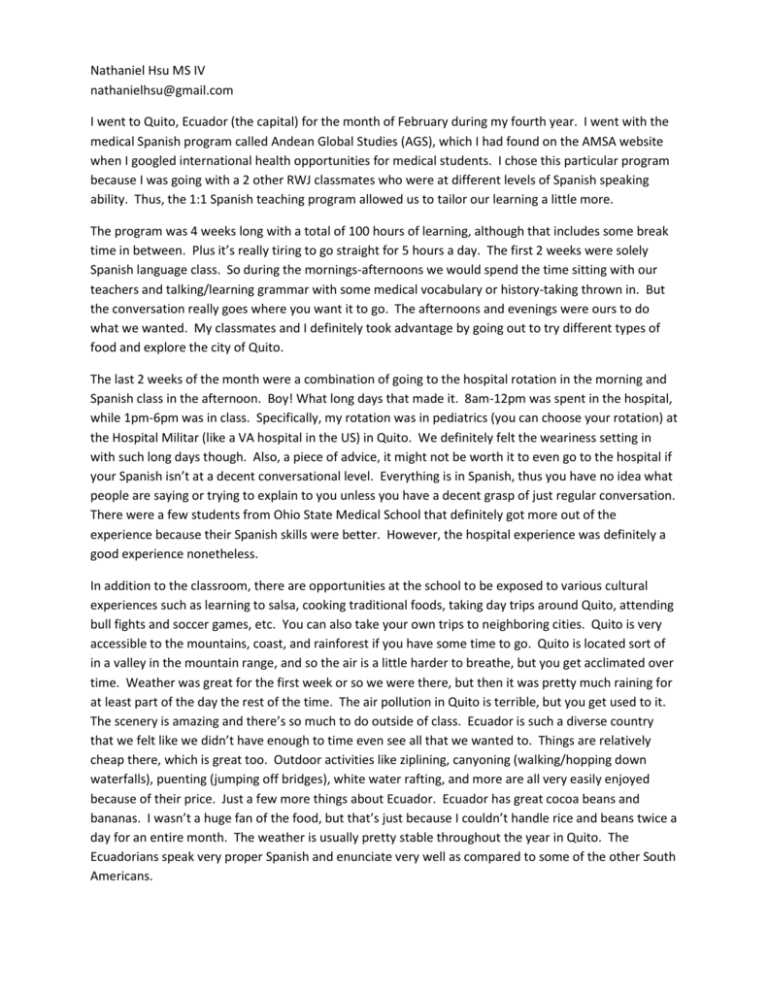
Nathaniel Hsu MS IV nathanielhsu@gmail.com I went to Quito, Ecuador (the capital) for the month of February during my fourth year. I went with the medical Spanish program called Andean Global Studies (AGS), which I had found on the AMSA website when I googled international health opportunities for medical students. I chose this particular program because I was going with a 2 other RWJ classmates who were at different levels of Spanish speaking ability. Thus, the 1:1 Spanish teaching program allowed us to tailor our learning a little more. The program was 4 weeks long with a total of 100 hours of learning, although that includes some break time in between. Plus it’s really tiring to go straight for 5 hours a day. The first 2 weeks were solely Spanish language class. So during the mornings-afternoons we would spend the time sitting with our teachers and talking/learning grammar with some medical vocabulary or history-taking thrown in. But the conversation really goes where you want it to go. The afternoons and evenings were ours to do what we wanted. My classmates and I definitely took advantage by going out to try different types of food and explore the city of Quito. The last 2 weeks of the month were a combination of going to the hospital rotation in the morning and Spanish class in the afternoon. Boy! What long days that made it. 8am-12pm was spent in the hospital, while 1pm-6pm was in class. Specifically, my rotation was in pediatrics (you can choose your rotation) at the Hospital Militar (like a VA hospital in the US) in Quito. We definitely felt the weariness setting in with such long days though. Also, a piece of advice, it might not be worth it to even go to the hospital if your Spanish isn’t at a decent conversational level. Everything is in Spanish, thus you have no idea what people are saying or trying to explain to you unless you have a decent grasp of just regular conversation. There were a few students from Ohio State Medical School that definitely got more out of the experience because their Spanish skills were better. However, the hospital experience was definitely a good experience nonetheless. In addition to the classroom, there are opportunities at the school to be exposed to various cultural experiences such as learning to salsa, cooking traditional foods, taking day trips around Quito, attending bull fights and soccer games, etc. You can also take your own trips to neighboring cities. Quito is very accessible to the mountains, coast, and rainforest if you have some time to go. Quito is located sort of in a valley in the mountain range, and so the air is a little harder to breathe, but you get acclimated over time. Weather was great for the first week or so we were there, but then it was pretty much raining for at least part of the day the rest of the time. The air pollution in Quito is terrible, but you get used to it. The scenery is amazing and there’s so much to do outside of class. Ecuador is such a diverse country that we felt like we didn’t have enough to time even see all that we wanted to. Things are relatively cheap there, which is great too. Outdoor activities like ziplining, canyoning (walking/hopping down waterfalls), puenting (jumping off bridges), white water rafting, and more are all very easily enjoyed because of their price. Just a few more things about Ecuador. Ecuador has great cocoa beans and bananas. I wasn’t a huge fan of the food, but that’s just because I couldn’t handle rice and beans twice a day for an entire month. The weather is usually pretty stable throughout the year in Quito. The Ecuadorians speak very proper Spanish and enunciate very well as compared to some of the other South Americans. Overall, this was a great learning experience for me, and I would highly recommend it to future students. My Spanish definitely improved a fair amount, even though I still have difficulty understanding people when they speak quickly. However, I was able to do decent histories and physicals on my peds sub-I the following month. I could actually translate for my residents at that point. There are a few medical Spanish programs that go to Ecuador such as CFHI, and I met some students from that program. In my opinion, I think I prefer AGS a bit more as it was more language intensive, yet was flexible enough to give you time to explore the great culture on your own. Finally, I have some pictures of my experience below. Figure 1. Attendings, residents, and medical students crowd around to see the x-rays. Computer usage on the wards was sparse. Figure 2 and 3. On the left, Justin, a fellow student from Ohio State, bonded well with our patients because of his great Spanish skills. On the right, the cardiologist is performing an echocardiogram for our baby patient who would occasionally become cyanotic. Figure 4. Beyond class, we got to go out to explore “Gringolandia” and the bars/nightlife found there. Figure 5. You never know what the weather will bring, especially on the mountains! We got hailed on when we went up to the Teleferico. Clearly not prepared. Figure 6. Even though we didn’t like the food overall, we still managed Figure 7. Canyoning. Amazing, that’s all.
